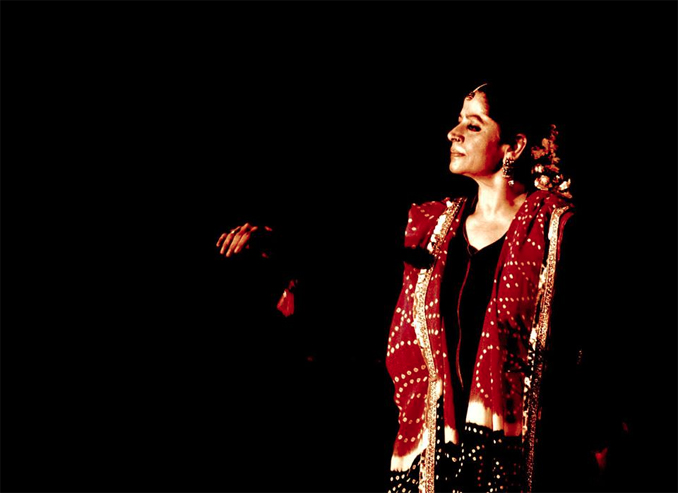Written by: Sarah Fatima - Posted on: December 13, 2013 |  Comments | 中国 (Chinese)
Comments | 中国 (Chinese)
Google Translation: اُردو | 中文
Mine was a hesitant introduction to Kathak.
One of the eight forms of Indian classical dances, Kathak traces its origins to the nomadic bards of ancient northern India, known as Kathakars or storytellers.
I was opinionated about it because it sounded serious, distant and complex like most things ‘classical’. Thus, when I received an invite for a Kathak performance by the celebrated Naheed Siddiqui, I had no idea what to expect.
The venue was Lahore’s famous Alhamra Arts Complex, located on the road that has enjoyed many affectionate references and glowing tributes of love by poets, historians and authors, i.e. the Mall road. The event was a four-day Urdu Conference.
The crowd was massive. Throngs of people, from friendly old ladies with silver hair to six year olds, a large gathering of the youth, men and women enthusiastically debating the rise and fall of Urdu poetry alongside faces from distant lands, all brimming with anticipation of what was coming.
In line with the event’s theme of classic, the weather outside was a fair representative of timeless winter evenings in Lahore. Inside, the hall was abuzz with activity. Rose petals and garlands of marigold surrounded the stage. A gentle fragrance of roses greeted everyone as they made way to their seats.
The performance was in four parts and opened with a piece by Ms. Siddiqui’s students. Dressed in orange, they floated onto the stage to the famous words of Allama Iqbal’s Sitaroun se Aagay (Beyond the Stars), which was composed by Hassan Mohiuddin and recited by Naheed Siddiqui herself.
 |
The audience sat mesmerized as Iqbal’s phenomenal poetry was set in motion by Rehan Bashir, Rachel Waterman, Ayesha Sarfraz and Mehreen Jillani. Word by word and move through move, they paid a tribute to the infinite possibilities at the feet of the human race. The whole act was very easy to understand, causing an instant connect, almost like the cosmos and the entire audience was in a movement aligned with the people on the stage. The impact was gripping, simultaneously leaving one awestruck and excited at the sudden awakening to all the prospects the universe held.
With this act, the stage was set for Naheed Siddqui to appear. Her first two dances were both based on iconic pieces, by those giants of Urdu poetry, Ghalib and Faiz. Their poetry was an excellent choice because they were familiar and moving, as well widely understood and celebrated.
Ms. Siddqui performance of Ghalib’s Aah Ko Chahiye was a true match to the beauty of the Urdu’s stalwart’s words. The accents of ghungroo and the poised movements gave every verse a life of its own. The integrity and spirit of words was upheld in her performance, such that with each new turn, the audience at once found itself witnessing something so familiar yet completely new.
The second performance was paired with the inspiring and defiant poem Zindagi Kee Aik Shaam (An Evening of my Life) by Faiz Ahmed Faiz. Naheed Siddiqui’s immaculate expressions and fluid movements made this poem come alive. Penned by Faiz in his days of imprisonment in the Lahore Jail, ironically not far away from where the present day Alhamra stands, this was a performance close to Ms. Siddqui’s own heart, the story of feeling bound and threatened, yet fighting back in the face of adversity with fierce determination, not being unknown to her. She had fought through bans, curbs and curfews, and even exile for pursuing her art in Pakistan. Her triumphant smile towards the close of the act was a tribute to the spirit of never giving up and the message hit home in a spectacular fashion as the audience applauded enthusiastically.
The last piece was a fascinating show and tell, called Teental. It was a lovely rendition of Kathak’s infusion with the Folk Dhamal. It was also the highlight of the evening as all individual pieces came together as one, and Ms. Siddqui displayed her true command over the art. The performance was a commentary on how nature is an inspiration, and also established a link of Kathak to what the Sufis understand as a human voyage of becoming one with the universe.
Music and vocals for the evening were given by Chand Khan and Suraj Khan, stars in their own right. As the evening drew to its close, everyone walked out grinning from ear to ear. Some were still in shock and others in a state of euphoria after witnessing a wonderful art form and the amazing talent that Pakistan holds close to its heart.
Mine was a beautiful introduction to Kathak.